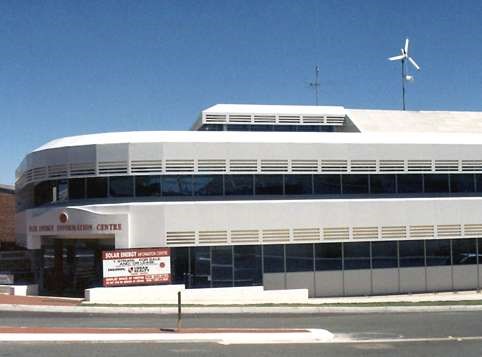A refresh of ‘solid thinking’ by Adj Professor Garry Baverstock AM, B Arch, MSC, LFAIA, February, 2020
A big distraction in the past decade has been the argument put forward by some researchers that somehow heavy weight materials are part of the problem with dealing with Climate Change. With Passive Solar Buildings this is simply not the case. Affordability and Viability of course need to be considered but there is still a strong case for quality buildings to incorporate thermal mass materials.

Picture of SEIC building 1993 winner of the National Energy Award
Simplistic Arguments
The simplistic reports by some researchers, and of course the framed and lightweight building industries lobbyists, over exaggerate the role of embodied energy. We have known for over 50 years that embodied energy only accounts for 2-20% of the energy and carbon over the lifecycle of a building. By far the odds are in favour of energy use being the main determinant of energy management strategy over the life cycle of a building.
Land Use Determinant
Not all land uses require long lasting buildings though. They also don’t require a solid capital investment because of the reasonably temporary nature proposed for the buildings and the scale of urban living in a built environment. This is where light or medium weight construction systems become more economically and environmentally attractive. Affordability is a big part of the criteria for materials selection in those cases. Lighter weight buildings are cheaper but not necessarily better. However, they do have their time and place in future sustainability. We need the best solutions for the right situation.
Solar Design Imperative
This means whether light or heavy buildings need 100% application of Solar Design. The reality is that it’s now a necessity in this era of heightened recognition of Human Impact on Climate Change (HICC), no matter what the level of thermal mass. Lighter weight buildings however can now benefit from the use of phase change chemical boards that can last up to 100 years. There are many competing but environmentally compatible approaches, even hybrid buildings. Using the correct material for the best effect is now the challenge, along with new smart technologies.
Landmark Architecture and Built to Last
However, a landmark building lasting over 50 to 100 years (in other words mainstream Architecture) is still better served by more expensive long lasting materials. Further energy reductions (30%) of energy use and consequently emissions occur when combined with Passive Solar Design strategies and thermal mass. Use of natural and low energy means of cross, night and attic ventilation, and harvesting natural solar gains in winter, are brought together with thermal inertia to yield results.
Of course longevity of the structure, low maintenance, fireproofing, earthquake proofing, tsunami resilience, acoustic separation of rooms and the even ambience of radiative-effects in internal spaces, enhancing comfort, are all extra benefits of solid heavy weight materials.
Thermal Mass Knowledge is Still True
Why am I so sure? Have a look at the report I completed for the Minerals and Energy Research Institute (MERIWA) done in 1994. This was extracted from my research and monitoring of the Solar Energy Information Centre 1989 – 1993. The building had an optimized level of thermal mass in the building that correlated with test tunnel results at Curtin University.
Evidence?
The report shows the results of theoretical and practical analysis demonstrating that a passive solar building in temperate climates will save 30% pa (directly attributable to the mass) over the year on heating and cooling using thermal inertia as one of the ingredients of the passive solar strategy. This is particularly true for air-conditioned buildings. It also reduces intermittent supplementary heating and cooling to negligible amounts for non-fully air-conditioned buildings as well. This greatly offsets any extra costs and embodied energy investment in the early years of a building.
You can read the report here.






